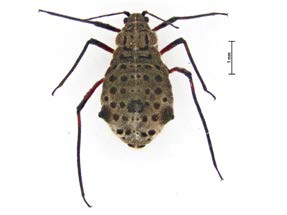PESTS AND DISEASES OF FORESTRY IN NEW ZEALAND
Disappearing act of the conspicuous giant willow aphid
Scion is the leading provider of forest-related knowledge in New Zealand
Formerly known as the Forest Research Institute, Scion has been a leader in research relating to forest health for over 50 years. The Rotorua-based Crown Research Institute continues to provide science that will protect all forests from damage caused by insect pests, pathogens and weeds. The information presented below arises from these research activities.
From Forest Health News 248, March 2014.

The giant willow aphid, Tuberolachnus salignus, which was first found in New Zealand late last year (see Forest Health News 246 March 2014), has begun its disappearing act much earlier than expected. This aphid is well known in the UK where it persists through the winter, despite frosts and snow, then mysteriously vanishes during spring and returns en masse each summer. Nobody knows about the aphid’s activities during its periods of disappearance. Here in New Zealand we expected to see a similar trend, with aphids visible through to about July. Instead, previously known populations have disappeared as early as April on both the North and South Islands. This may indicate that this species is indeed quite a recent import and has not yet acclimatized to the seasons of the Southern Hemisphere. Since March it has been found in Wanganui and Buller. This makes Rangitikei the only region on the North Island in which it has not been reported, and completes the regions on the entire western side of the country. This distribution supports the suggestion that it may have arrived in New Zealand from Australia. Although the December 2013 record from Auckland was the first for Australasia, it has since been found in Tasmania (March 2014) and Canberra (April 2014). It will be interesting to see what next year brings. To be continued……
Stephanie Sopow
This information is intended for general interest only. It is not intended to be a substitute for specific specialist advice on any matter and should not be relied on for that purpose. Scion will not be liable for any direct, indirect, incidental, special, consequential or exemplary damages, loss of profits, or any other intangible losses that result from using the information provided on this site.
(Scion is the trading name of the New Zealand Forest Research Institute Limited.)



